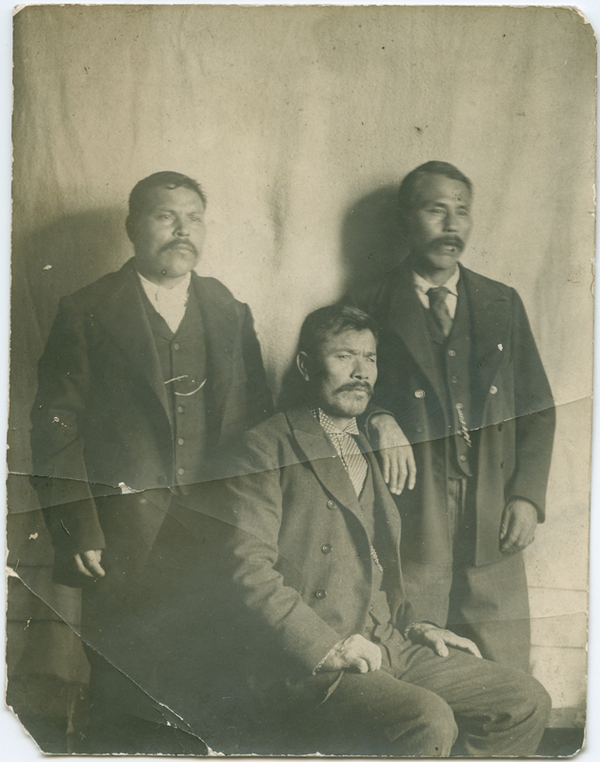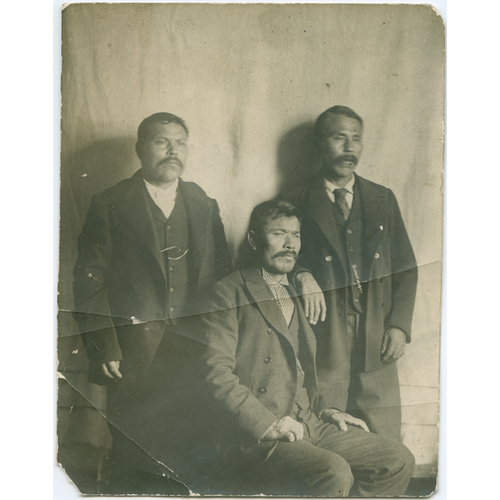
Source: Link
RUSS, AMOS (he carried the Haida name Gedanst), Christian convert and Haida leader and band councillor; b. in 1849 or 1850 in Skidegate (B.C.); m. 10 Nov. 1879 Agnes Hubbs, whose Haida name was Jaadahl Sing.gang.nga (d. 1964), a widow, in Fort Simpson (also known as Port Simpson in the late 19th century and officially as Lax Kw’alaams since 1986), B.C., and they had 11 children; d. 10 Nov. 1934 in Skidegate.
Gedanst was born into a family of high rank in the Raven clan of the Haida, a seafaring people with territory encompassing the Queen Charlotte Islands, which they called Haida Gwaii (the official name since 2010), and part of the Alexander Archipelago in what is now southeastern Alaska. According to early printed sources in English he was expected to inherit the mantle of Chief Skidegate, whom the sources describe as Gedanst’s grandfather. In Haida oral tradition, however, this chief is known as Paul Nang jingwas, who was married to Gedanst’s maternal aunt and was one of the most powerful Haida leaders at that time. As was customary for young men of noble lineage, Gedanst underwent severe physical training, fasts, and ordeals which were designed to strengthen future leaders – and, it seems likely, to weed out the weak ones.
By the time Gedanst was in his teens the Haida, whose numbers in the 1830s had been estimated by officers of the Hudson’s Bay Company to be about 8,000, were in a precipitous decline accelerated by the disastrous smallpox epidemic of 1862. At the population’s lowest point, in 1915, there would be fewer than 600 individuals. Moving from this atmosphere of social and cultural crisis, Gedanst visited Victoria as a young man, probably in the early 1870s. There, throughout most of the winter, he attended meetings of the Methodist Church held by a daughter of the Reverend William Pollard, one of Maria Heathfield Pollard’s sisters. Gedanst became convinced of the truth and value of Christianity, both for himself and for the Haida in Skidegate. Although the nature of his Christian beliefs is not known, the growing body of literature exploring indigenous religious conversions observes that 19th-century figures, such as Gedanst, were engaged in complex processes of cultural transformation in which the Christianity they adopted was being indigenized at the same time as they were being Christianized. Like certain early converts, he took the name of the man who baptized him, Amos E. Russ, a minister who later became financial secretary of the British Columbia district of the Methodist Church. Gedanst, now Amos Russ, was one of the first Haida to have converted to Christianity.
Russ returned to Skidegate determined to be a good Christian and to encourage others to convert as well. This zeal disappointed and enraged Paul Nang jingwas, who did everything he could to thwart his heir’s actions. At one point the chief demanded that Russ renounce his new religion; Russ is said to have responded by going home and chopping up his ancestral totem poles for firewood. He subsequently moved to Fort Simpson, where he met his future wife.
Agnes was the daughter of Qawankie, a Haida woman from Frederick Island, in the northwestern part of the Queen Charlotte archipelago, and an American, Charles Hubbs (Hobbs). According to Haida oral tradition she was born in Masset in 1858 and adopted and raised by her aunt’s husband, Chief Harry Weah. By 1879 she was already the widow of Chief Steilta. Following her husband’s death she became a student at the boarding school for young indigenous women that had been established in Fort Simpson by Emma Jane Crosby, wife of Methodist missionary Thomas Crosby*. Agnes and Amos were married that year. Their honeymoon consisted of a missionary tour to the Nass River region with Thomas Crosby. Soon afterwards, Nang jingwas relented, and the couple established themselves in Russ’s family home. Russ continued his efforts to spread the gospel in the years following his marriage, first on the mainland and then on the Queen Charlotte Islands.
When Russ was told by Crosby that there were no funds for a Methodist missionary in Skidegate, he tried to convince the Church Missionary Society to send a Church of England clergyman. In 1883 he persuaded George Robinson, the teacher at the Methodist school in Fort Simpson, to return home with him to teach until an ordained minister could be sent. Five years later Russ was one of ten men who affixed their marks to a document entitled “Statement of chiefs and others at Skidegate, Queen Charlotte’s Islands,” in which they complained that the federal government was neglecting the health and education of their people and asked if it was because they were Methodists rather than members of the Church of England. The text was part of a series forwarded by the Methodist Missionary Society to the superintendent of Indian affairs, Israel Wood Powell*, to support claims that Methodist missions were being discriminated against in favour of those belonging to other denominations.
Among Robinson’s and Russ’s early Haida converts were Jim and Sarah Kelly, whose son, Peter Reginald*, would marry Russ’s daughter Gertrude. The younger Kelly would become the first regularly ordained aboriginal Methodist minister in the province and chairman of the Allied Indian Tribes of British Columbia, which struggled until its dissolution in 1928 for government recognition of native land titles. This campaign began in earnest in the early 1900s, when the Cowichan, the Nisga’a, and other aboriginal peoples turned to British law to support their claims.
After the federal Liberal administration of Sir Wilfrid Laurier* was turned out of office in 1911, Conservative premier Richard McBride* and James Andrew Joseph McKenna*, who represented the new federal Conservative government of Robert Laird Borden, agreed to shelve the issue of Indian titles and establish a commission to report and make recommendations on the question of Indian reserves. The royal commission on Indian affairs for the province of British Columbia, also known as the McKenna–McBride commission, visited Skidegate in September 1913, and Russ – in his sixties – was one of the elders and band councillors who explained why the Skidegate Haida were reluctant to appear before the commission. Describing himself as a “Christian gentleman,” Russ told the commissioners that he and his people were greatly concerned about their lands. Pointing to the totem poles, he affirmed that they were “the same to us as the white man’s pre-emption stakes are to them.” As far back as anyone could remember, he said, the islands had belonged to the Haida, who did not know who had decided to name them after an English queen. Russ added that if he had taken a piece of land that did not belong to him, he would have renamed it as well. He declared that the Haida had “never had a fight” over the land (they had never lost it in battle), as the Boers and the English had, so they could not understand in what capacity the government claimed it. Although the Haida had respected the missionary teaching that they should not take things that belong to others, the government was, “day by day,” taking their land and selling it. The Haida had hired a lawyer to press their claims before the Judicial Committee of the Privy Council and would speak to the commissioners about their reserves only if doing so would not compromise their land claims. Because the commissioners refused to give such a guarantee, the Haida were unwilling to have further discussions with them.
As well as being a religious and political leader, Amos Russ played an active role in promoting the economic development of his community. A fisher, a trapper, and a skilled carpenter, he built at least three small churches on the Queen Charlotte Islands (including one at Skidegate), erected a mill run by water power, and made furniture. He was remembered by one of his daughters as being strict, not allowing her and her sisters to go to village dances.
Russ passed away in his mid eighties, and was survived by his wife, nine children, twenty-eight grandchildren, and two great-grandchildren. A large funeral procession was held in Skidegate and tributes were given in the Haida language. Agnes Russ died on 2 June 1964 at the age of about 105, and in the early 21st century she is still fondly remembered by the Haida.
For their assistance the authors wish to thank Blair Galston, archivist at the Bob Stewart Arch. (Vancouver) of the UCC, and Professor Susan Neylan, Waterloo, Ont. The document entitled “Statement of chiefs and others at Skidegate, Queen Charlotte’s Islands,” signed by Amos Russ and other Haida chiefs, was published in Methodist Missionary Soc., Letter … to the superintendent-general of Indian affairs respecting British Columbia troubles … ([Toronto?, 1889?]).
BCA, GR-2951, no.1934-09-018675. Private arch., Hamar Foster (Victoria), Interviews with Reg Kelly, November 1995–April 1996; Megan Harvey (Vancouver), Interview with Captain Gold (Richard Wilson), 3 July 2014. UCC, Bob Stewart Arch., Port Simpson marriage register, 10 Nov. 1879. J. H. van den Brink, The Haida Indians: cultural change mainly between 1876–1970 (Leiden, Netherlands, 1974). Can., Royal commission on Indian affairs for the prov. of B.C., Report (4v., Victoria, 1916). W. H. Collison, In the wake of the war canoe …, ed. Charles Lillard (Victoria, 1981). “Colourful Indian character called to his forefathers,” Western Recorder (Victoria), December 1934. Thomas Crosby, Up and down the North Pacific coast by canoe and mission ship (Toronto, 1914). K. E. Dalzell, The Queen Charlotte Islands, 1774–1966 (Terrace, B.C., 1968). Jan Hare and Jean Barman, Good intentions gone awry: Emma Crosby and the Methodist mission on the northwest coast (Vancouver, 2006). Charles Harrison, The Hydah mission, Queen Charlotte’s Islands: an account of the mission and people, with a descriptive letter (London, [1884?]). R. W. Henderson, These hundred years: the United Church of Canada in the Queen Charlotte Islands, 1884–1984 ([Queen Charlotte Islands [Haida Gwaii, B.C.], 1985?]). Alan Morley, Roar of the breakers: a biography of Peter Kelly (Toronto, 1967). Imbert Orchard, The Queen Charlotte Islands: the Agnes Russ story: people in landscape (Victoria, [1977]). F. E. Runnalls, It’s God’s country: a review of the United Church and its founding partners, the Congregational, Methodist and Presbyterian churches in British Columbia (n.p., 1974). [A. D.] Stephenson, One hundred years of Canadian Methodist missions, 1824–1924 (Toronto, 1925). C. M. Tate, Our Indian missions in British Columbia (Toronto, [1899?]).
Cite This Article
Hamar Foster and Megan Harvey, “RUSS, AMOS (Gedanst),” in Dictionary of Canadian Biography, vol. 16, University of Toronto/Université Laval, 2003–, accessed January 20, 2026, https://www.biographi.ca/en/bio/russ_amos_16E.html.
The citation above shows the format for footnotes and endnotes according to the Chicago manual of style (16th edition). Information to be used in other citation formats:
| Permalink: | https://www.biographi.ca/en/bio/russ_amos_16E.html |
| Author of Article: | Hamar Foster and Megan Harvey |
| Title of Article: | RUSS, AMOS (Gedanst) |
| Publication Name: | Dictionary of Canadian Biography, vol. 16 |
| Publisher: | University of Toronto/Université Laval |
| Year of publication: | 2018 |
| Year of revision: | 2018 |
| Access Date: | January 20, 2026 |



